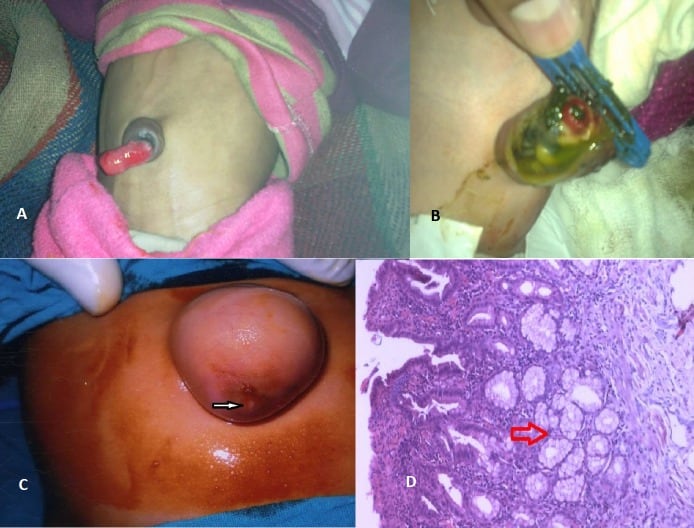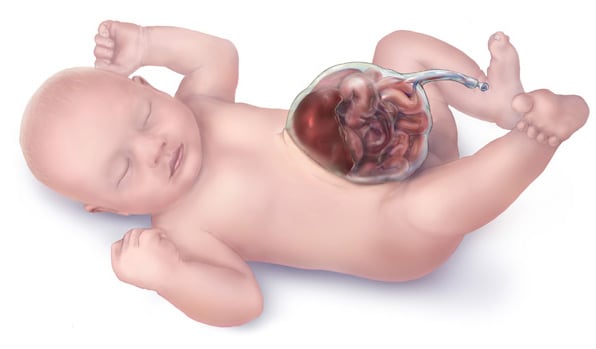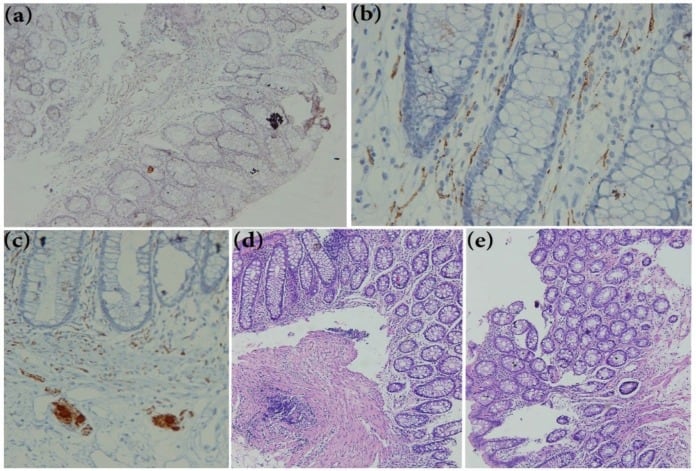Rarely agenesis or hypoplasia of the right lobe of the liver is seen. Ectopic liver tissue may be attached to the spleen, adrenals or pancreas.
It occurs due to defects in recanalization of the duodenum. It is seen in the area surrounding the ampulla of Vater. Prenatally polyhydramnios is seen. It presents postnatally with bilious vomiting typically beginning a few hours after birth, abdominal swelling, constipation and jaundice. Double-bubble sign is seen on abdominal X ray. 30% of cases are associated with Down’s syndrome. Many cases are also associated with annular pancreas, malrotation, TEF, cardiac malformations like PDA and endocardial cushion defects and renal defects. Few cases are inherited as an autosomal recessive trait.

In contrast to duodenal atresia, jejunoileal atresias are caused due to disruption in blood supply of the small intestine. The underlying cause is a partially or completely absent mesentery that leads to twisting of the intestine around the marginal artery causing ischemia and death of cells. The vascular insult may also be due to local causes like thrombosis and vasoconstriction. Infants of mothers taking ergotamine, excess caffeine, cocaine abuse, pseudoephedrine and smoking in pregnancy are at high risk for jejunoileal atresias. It presents as failure to thrive, bilious vomiting, abdominal distension, jaundice, failure to pass meconium after birth and constipation. Prenatal ultrasound or MRI can be used for diagnosis. Imaging shows polyhydramnios, dilated bowel loops with air-fluid levels, hyperechoic bowel and ascites.
The vitelline duct connects the yolk sac to the midgut. Anomalies are more common in males.

Figure 1: A- Prolapsed patent VID. B- Meconium discharge from patent VID. C- Umbilical hernia harboring Meckel’s diverticulum. Arrow shows site of attachment of Meckel’s diverticulum to the underside of skin. D- Histopathology showing ectopic gastric mucosa (Arrow).
Persistent vitelline duct: When the vitelline duct fails to close. It presents as a persistent draining fistula at the umbilicus.
Omphalomesenteric duct cyst: It occurs when the vitelline duct obliterates at both ends but remains patent in the middle. The cyst attaches to the umbilicus and/or bowel.
It is a ventral abdominal wall defect caused by failure of the midgut loops to return back to the abdominal cavity during fetal development. Herniation of visceral organs is seen in the midline, at the base of the umbilical cord and the contents are covered by parietal peritoneum, amnion and Wharton jelly. Liver is a common content of the omphalocele. Poly or oligohydramnios and fetal ascites can be detected. Amniotic fluid AFP and acetylcholinesterase levels may be elevated. There is increased risk in infants born to mothers who smoke or drink alcohol, are obese or take SSRIs. Omphalocele is commonly associated with chromosomal abnormalities, neural tube defects, cleft palate, limb defects, Beckwith-Wiedemann syndrome, exstrophy of bladder, anal atresia, renal and cardiac defects.

It is a ventral abdominal wall defect causing herniation of abdominal contents through a paramedian defect located to the right of the umbilicus. The bowel contents are not covered by a membrane. In contrast to omphalocele, the liver never herniates in gastroschisis. Both maternal serum and amniotic fluid levels of AFP are elevated. Prenatal ultrasound shows herniated bowel and polyhydramnios. IUGR is frequently associated. There is increased risk in infants born to teenage mothers and those who are smokers or who consume alcohol. GERD may develop postnatally.

The developing gut undergoes a 270 degree rotation along the superior mesenteric artery as the axis, followed by fixation to their respective normal anatomical positions. Any abnormality in this rotation and fixation leads to malrotation. It may present variably depending on the stage at which rotation and fixation is arrested in the form of narrow base of mesentery predisposing to midgut volvulus, duodenal obstruction, misplaced and mobile caecum, Ladd’s bands and internal hernias. It is commonly associated with diaphragmatic hernia, gastroschisis, omphalocele and intestinal atresias. Malrotation is more common in males. Midgut volvulus is a feared complication of malrotation, presenting with sudden onset of bilious vomiting, diffuse abdominal pain and distension. It may cause gangrene of the bowel if not operated immediately. Ladd’s bands are fibrous peritoneal bands extending from the misplaced cecum and crossing over the duodenum. They may compress the duodenum causing obstruction. Imaging in malrotation may show telltale signs of intestinal obstruction with pneumatosis intestinalis in severe cases with sepsis. Upper GI series shows variable findings including abrupt cessation of contrast, corkscrew pattern, obstruction etc. Mutations in BCL6 gene have been implicated in malrotation.
The terminal hindgut ends in an endoderm lined pouch called the cloaca. The cloaca communicates with the lower urogenital tract as well. The urorectal septum, which has a mesodermal origin, divides the cloaca into the urogenital sinus ventrally and the rectoanal canal dorsally. The rectoanal canal forms the rectum and upper anal canal while the urorectal septum forms the perineal body. The cloacal membrane is formed by endoderm from the cloaca and ectoderm of the opposing body wall. Normally, the cloacal membrane disintegrates. The lower anal canal is formed by the fusion of ectodermal anal tubercles or proctodeum.
Persistent cloaca syndrome: The cloaca persists causing the rectum, vagina and urinary tract to open through a single opening located at the normal site of the urethra. It is often associated with tethered spinal cord.
Imperforate anus: It is an umbrella term for anorectal malformations presenting with absence of a normally located anal opening. The cloacal membrane fails to break down. The anorectal canal instead opens in the form of a fistula into the perineum and is connected to the urinary tract and reproductive tract structures. It has often been associated with Down’s syndrome, single umbilical artery, VACTERL defects, in vitro fertilization, maternal diabetes and intranatal exposure to thalidomide and retinoic acid. It is more common in males. VSD and PDA can be present.
The neurons in the submucosal and myenteric plexuses are derived from the neural crest. In Hirschsprung disease, the neural crest cells fail to migrate into the colon causing an aganglionic segment. The aganglionic segment cannot relax and it stays tonically contracted causing functional obstruction. The proximal colon dilates and hence the name congenital megacolon. Sigmoid colon is the most commonly affected segment. It presents as failure to pass meconium at birth, poor weight gain, slow growth, constipation, bowel obstruction and vomiting. Enterocolitis and toxic megacolon can occur as complications. Rectal examination shows tight anal sphincter and explosive discharge of stool and gas. RET, SEMA3, NRG1 and EDNRB genes have been implicated in the pathogenesis of Hirschsprung disease. It is associated with Down syndrome, cartilage hair hypoplasia syndrome, MEN type 2 etc. Imaging shows classic finding of a narrowed distal colon with proximal dilation and a transition zone in between. Rectal contrast is retained for more than 24 hours following a barium enema in Hirschsprung disease. Anorectal manometry (not done commonly) shows lack of relaxation reflex of the internal sphincter after rectal distension. Gold standard of diagnosis is full thickness rectal biopsy showing absent ganglion cells. Suction biopsy can also be done, though it is less sensitive. H and E, acetylcholinesterase staining showing hypertrophied nerve trunks in the bowel wall or immunohistochemical staining with calretinin are done.

Rectal biopsy sections of suspicion patient for Hirschsprung disease (HD). (a) Showing negative reaction after calretinin immunohistochemistry staining (×250). (b) Calretinin positive immunohistochemistry on a normal rectal biopsy sections extended to the lamina propria easily detectable at ×400 magnification in submucosae. © Calretinin positive Immunoreactivity in Ganglion cells of submucosa (×400). (d, e) H&E staining rectal biopsy of (d) normal tissue and (e) HD patient
Sign up for free to take 7 quiz questions on this topic